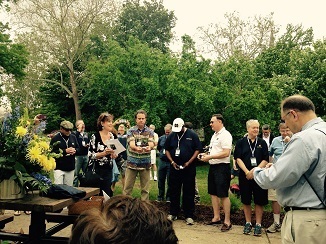
Notre Dame’s Class of ’76 turned their 40th reunion into an extraordinary celebration of renewal and stewardship of the natural world. On Friday of Reunion weekend, they planted a butterfly garden adjacent to St. Joseph’s Lake and immediately opposite the Grotto. They included a wide variety of beautiful plants that are attractive to different species of butterfly as well as milkweed to support monarchs as they pass through South Bend on their transcontinental migration.
On Sunday of Reunion Weekend, over 100 alumni dedicated the garden following a beautiful Mass at the Grotto. They released 24 butterflies, one for each of the members of their class who have passed away. Fr. Joe Corpora, Director of the Catholic School Advantage Program at the Alliance for Catholic Education, blessed the garden, saying that it should always be a place that reminds visitors of God’s gifts of the natural world.
Frank Fransioli ’76 conceived of the idea of planning a butterfly garden at ND many months ago. In his welcoming remarks, he thanked all those who volunteered their labor, who donated to purchase the plants and start building an endowment for the garden, and who thought of the very appropriate name, “Our Lady’s Butterfly Garden”.
“St. Francis encouraged his monks to leave one spot on the monastery grounds that was still a wild place,” said Fransioli. “This garden will be an informal, wild place. Here we've planted native, not ornamental plants. We've even included some weeds.”
Starting in the Fall, Notre Dame students will start using the butterfly garden as a living laboratory as well as a restful spot for meditation. A new class titled Sustainability at Notre Dame will visit the butterfly garden as part of its exploration of the role of sustainability in the campus landscape.
“Pope Francis whispers to us that we must care for our common home,” concluded Fransioli. “This represents a modest beginning, a small step to repair the natural order.”